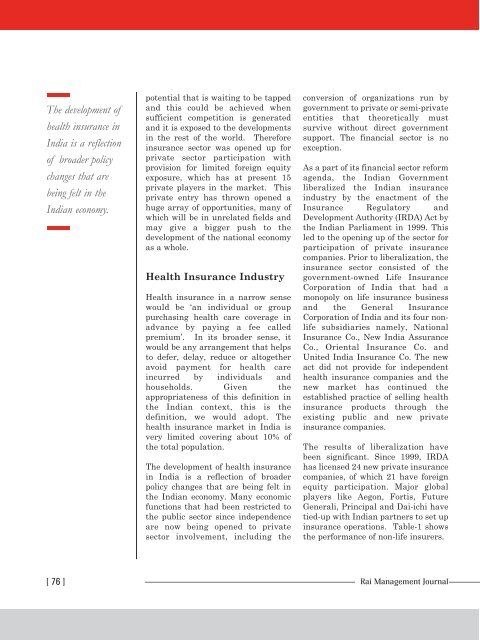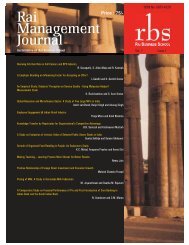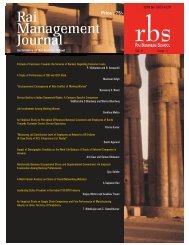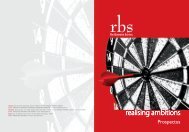The development ofhealth insurance inIndia is a reflectionof broader policychanges that arebeing felt in theIndian economy.potential that is waiting to be tappedand this could be achieved whensufficient competition is generatedand it is exposed to the developmentsin the rest of the world. Thereforeinsurance sector was opened up forprivate sector participation withprovision for limited foreign equityexposure, which has at present 15private players in the market. Thisprivate entry has thrown opened ahuge array of opportunities, many ofwhich will be in unrelated fields andmay give a bigger push to thedevelopment of the national economyas a whole.Health Insurance IndustryHealth insurance in a narrow sensewould be ‘an individual or grouppurchasing health care coverage inadvance by paying a fee calledpremium’. In its broader sense, itwould be any arrangement that helpsto defer, delay, reduce or altogetheravoid payment for health careincurred by individuals andhouseholds. Given theappropriateness of this definition inthe Indian context, this is thedefinition, we would adopt. Thehealth insurance market in India isvery limited covering about 10% ofthe total population.The development of health insurancein India is a reflection of broaderpolicy changes that are being felt inthe Indian economy. Many economicfunctions that had been restricted tothe public sector since independenceare now being opened to privatesector involvement, including theconversion of organizations run bygovernment to private or semi-privateentities that theoretically mustsurvive without direct governmentsupport. The financial sector is noexception.As a part of its financial sector reformagenda, the Indian Governmentliberalized the Indian insuranceindustry by the enactment of theInsurance Regulatory andDevelopment Authority (IRDA) Act bythe Indian Parliament in 1999. Thisled to the opening up of the sector forparticipation of private insurancecompanies. Prior to liberalization, theinsurance sector consisted of thegovernment-owned Life InsuranceCorporation of India that had amonopoly on life insurance businessand the General InsuranceCorporation of India and its four nonlifesubsidiaries namely, NationalInsurance Co., New India AssuranceCo., Oriental Insurance Co. andUnited India Insurance Co. The newact did not provide for independenthealth insurance companies and thenew market has continued theestablished practice of selling healthinsurance products through theexisting public and new privateinsurance companies.The results of liberalization havebeen significant. Since 1999, IRDAhas licensed 24 new private insurancecompanies, of which 21 have foreignequity participation. Major globalplayers like Aegon, Fortis, FutureGenerali, Principal and Dai-ichi havetied-up with Indian partners to set upinsurance operations. Table-1 showsthe performance of non-life insurers.[ 76 ] Rai Management Journal
Table-1: Gross Premium from Business in India – <strong>No</strong>n-Life InsurersInsurerPremium (Rs. Crores)Policies issued2007-2008 2007-2008 2007-2008 2007-2008Public16831.85(3.52)18030.75(7.12)38547040(13.47)45137181(17.09)Private10991.89(27.12)12321.09(12.09)18703219(47.36)21922906(17.21)Total27823.74(11.72)30351.84(9.09)57250259(22.69)67060087(17.13)<strong>No</strong>te: Figures in brackets indicates growth over previous yearSource: IRDADEVELOPMENT OFPRIVATE HEALTHINSURANCEWhile the new law establishing theframework for the private insuranceindustry did not create a separatelegal structure within which privatehealth insurance would operate, itanticipated a modern broadly definedhealth insurance market through theestablishment of an independentregulator of companies. Inimplementing regulations in 2000 forthe registration of insurancecompanies, IRDA defines healthinsurance as: the effecting of contractswhich provide sickness benefits ormedical, surgical or hospital expensebenefits, whether in-patient or outpatient,on an indemnity,reimbursement, service, prepaid,hospital or other plans, includingassured and long term care.There is some debate whether theregulatory definition of healthinsurance actually enables either lifeDecember 2010 Vol. 7, Issue 2or nonlife companies to write healthinsurance policies. However, inpractice, both do. Since liberalization,most health insurance policies havebeen written by non-life insurancecompanies whereas life-insurers sellhealth insurance in the form of healthriders to their life policies. Of late thisline of differentiation has dimmed.<strong>No</strong>n-life insurers have introducedlong-term policies and benefit planscovering critical illnesses and policiesthat provide cash payments if aninsured person is hospitalized withcertain illnesses.Although most insurers are coveredunder the new insurance Act, Section118 of the Insurance Act, 1938,exempts the application of the Act toany trade union registered under theIndian Trade Union Act, 1926; or toany provident fund to which theprovisions of the Provident Funds Act,1925, apply; or to any insurancebusiness carried on by the CentralGovernment or a State Governmentrelating to properties belonging to it or...IRDA defineshealth insurance as:the effecting ofcontracts whichprovide sicknessbenefits or medical,surgical or hospitalexpense benefits,whether in-patient orout-patient, on anindemnity,reimbursement,service, prepaid,hospital or otherplans, includingassured and longterm care.[ 77 ]
- Page 1:
RaiManagementJournalAn Initiative o
- Page 4 and 5:
From the Editor’s DeskIt gives me
- Page 6 and 7:
Training Delivery and Methodology i
- Page 8 and 9:
The work force ofan organizationbec
- Page 10 and 11:
Choice of trainingand delivery meth
- Page 12 and 13:
Research studies ofmemory following
- Page 14 and 15:
Table -3: Perception of employees r
- Page 16:
Table -5: Perception of employees r
- Page 19 and 20:
Table -8: Perception of employees r
- Page 21 and 22:
Reference• Bhatia, S.K (1989).
- Page 23 and 24:
celebrity. Keeping these two things
- Page 25 and 26:
Figure IIFigure IIIDecember 2010 Vo
- Page 27 and 28: • The Pepsi Campaign after theInd
- Page 29 and 30: Table showing PERCENTAGE OF FAMILIA
- Page 31 and 32: NAMETable showing PERCENTAGE OF Q-S
- Page 33 and 34: and Irfan Pathan have beenranked at
- Page 35 and 36: REFERENCESBOOKS -• Cloe, E. Kenne
- Page 37 and 38: sations moving forward?In order to
- Page 39 and 40: When studying the essentials of ano
- Page 41 and 42: The effectiveness of the currentmot
- Page 43 and 44: Fig.3: Ranking of Motivational Fact
- Page 46 and 47: It seems clear thatIndian organisat
- Page 48 and 49: • Kumar, N. (2001) Soft Ware Indu
- Page 51 and 52: table 1. On an average, restaurants
- Page 53 and 54: is also a major factor which effect
- Page 55 and 56: careful analysis of the market ands
- Page 57 and 58: Table 5: Size of the restaurants in
- Page 59 and 60: Table 12: Strategy for promoting re
- Page 62 and 63: ...there will be atextile boom inIn
- Page 64 and 65: apparel industry, be it export ordo
- Page 67 and 68: It is clear from table 5 that solep
- Page 69 and 70: Table 8: Ranking of various problem
- Page 71 and 72: It is evident from table 10 that th
- Page 73 and 74: Table 12 shows that the respondents
- Page 75 and 76: to more than 100 countries worldwid
- Page 77: An Empirical Study on Indian Health
- Page 81 and 82: On August 15, 2007, the PrimeMinist
- Page 83 and 84: data collected from the respondents
- Page 85 and 86: Profile, purpose and investingpract
- Page 87 and 88: The Percentage Rank Analysis isappl
- Page 89 and 90: Based on the Average PercentageAnal
- Page 91 and 92: OBJECTIVE-3:To study the factors th
- Page 93 and 94: FUTURE CHANGEEXPECTEDAt present whe
- Page 95 and 96: Random walks in stock market prices
- Page 97 and 98: eported forsome indices.Kok and Lee
- Page 99 and 100: SAMPLEFrom the list of Oil and Gas
- Page 101 and 102: • Barnes, P. (1986) Thin trading
- Page 103 and 104: Thus, this paper has incorporateddi
- Page 105 and 106: hypotheses of the information conte
- Page 107 and 108: The present study addresses itsobje
- Page 109 and 110: Deviations are similarly compared i
- Page 111 and 112: The remaining banks did not show an
- Page 113 and 114: at this time the Telecom sector had
- Page 115 and 116: constant dividend every year on the
- Page 118 and 119: Organized retail canbe defined as a
- Page 120 and 121: In the midst of the unorganised ret
- Page 122 and 123: convenience are some of majorattrib
- Page 124 and 125: STATISTICAL ANALYSESThe 475 usable
- Page 126 and 127: The Table 4 gives the 6 extracted f
- Page 128 and 129:
The most significant factor thatdet
- Page 130 and 131:
• Mulhern, F., and Leone, R., 199
- Page 132 and 133:
carefully/exactly identified group
- Page 134 and 135:
interaction effects. Variations in
- Page 136 and 137:
eduction, indicating that the decli
- Page 138 and 139:
Rs.10000 to Rs.20000 prefer maligai
- Page 140 and 141:
Table 6: Reason for purchasing at a
- Page 142 and 143:
Table 9: Monthly income and frequen
- Page 144 and 145:
Once “time spent” by the users
- Page 146 and 147:
Out of 200 respondents 111responden
- Page 148 and 149:
etail stores are facing.VII. PREFER
- Page 150 and 151:
From table 22 it can be inferred th
- Page 152 and 153:
Role of Relationship in Pharmaceuti
- Page 154 and 155:
Wholesaler, animportantmiddleman fo
- Page 156 and 157:
... a medicalrepresentative needsto
- Page 158 and 159:
ole in selling the products. And74(
- Page 160 and 161:
On the Basis ofQualificationOut of
- Page 162 and 163:
Figure 7Figure 8[ 160 ] Rai Managem
- Page 164 and 165:
Empirical Study On PerformanceMeasu
- Page 166 and 167:
these non- productive assets wasalm
- Page 168 and 169:
Tools for Analysis:First of all the
- Page 170 and 171:
... the commonstrength of theplasti
- Page 172 and 173:
adversely. Thus the common problems
- Page 174 and 175:
• Nimbalkar .B. Chairman & Managi
- Page 176 and 177:
Customersatisfaction and theservice
- Page 178 and 179:
The tourismindustry of Indiahas exp
- Page 180 and 181:
The hotel industryof India is one o
- Page 182 and 183:
Reichheld and sche(2000) embracedth
- Page 184 and 185:
Customersatisfaction is verycrucial
- Page 186 and 187:
2010 and 2020 respectively whichcal
- Page 188 and 189:
• Zineldin, m. (1999), ``explorin
- Page 190:
RNI NO.: DELENG/2004/12383Printed a





